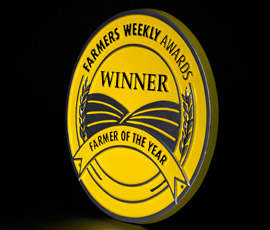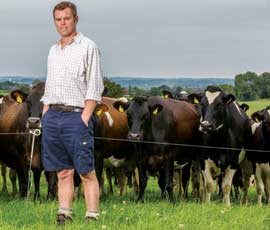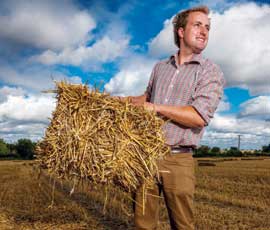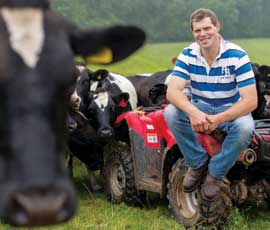2013 Farmers Weekly Young Farmer finalists revealed

Hard work, simple solutions and precision application make this year’s three innovative Young Farmer of the Year finalists seem like they’ve been in the industry for years. Will Frazer reports

Rupert Major
Castle Hayes Farm, Tutbury, Staffs
Rupert Major has brought a level of management and leadership to a family dairy business, unprecedented for someone so young. Determined to be able to competitively produce milk and make good profits at world prices he has developed a military-style farming operation.
In 2005 Rupert returned home from New Zealand to start the process of taking over the family business. His enthusiasm and meticulous approach to managing the farm’s succession means he has now taken over nearly all aspects of farm management.
The business witnessed wholesale changes under this new leadership. The arable side was closed down, 164ha of arable land sown out in long-term grass leys and large amounts of machinery sold off. Ninety 3ha paddocks were fenced and tracks, feeders and water troughs were installed across the farm. Thus he started the process of growing the herd of 200 dairy cows to the 500-strong herd it is today.
These were bold decisions to be taken so early in his farming career but they were all based on Rupert’s analysis of the numbers, which showed that dairy farming would make five or six times the profit of the arable enterprise. He is yet to be proved wrong.
The cows are Jersey cross Friesians and while small and low- yielding, they are easy calving and can efficiently convert grass to milk. The average 500kg cow produces 400kg of milk solids, which makes these animals effective money-making machines.
FARM FACTS
- 283ha of tenanted pasture with four full-time employees
- Milking herd of 500 Jersey cross Friesians, with 175 heifers, 180 calves and 14 bulls
- 280 sows, 1,700 finished pigs, 1,400 weaners, plus 120 ewes and 50 Simmental suckler cows
- Average yield of 5,000 litres a cow a year off 500kg of concentrate. Has increased Comparable Farm Profit from 8p/litre to 12p/litre in four years
Rupert benchmarks his business with the local discussion group – The Turf Accountants – using comparable farm profit. The focus is on growing output of milk solids a hectare, rather than the more conventional output a cow.
This is achieved through rearing more cows, increasing the quality of milk constituents, stock sales and of course a stringent management regime. The result has been an increased profit of £327/ha and milk volume sold up from 1.46m litres to 2.32m litres over the course of five years.
Rearing heifers as efficiently as possible is what fuels the farm’s propensity for growth, and the focus is on a herd that reproduces as efficiently as possible.
“We have very little reproductive intervention as we don’t want to breed from cows that aren’t naturally fertile,” he says.
A 60% conception rate at first service demonstrates these cows are well trained in all the essential aspects of life. “These are low-maintenance 4×4 machines, not Formula One racing cars,” he says.
Youngstock rearing is one of Rupert’s main strengths, with an active weighing, sorting and regrading process ensuring smaller animals get the attention required to keep them up to speed with the rest of the herd. Optimising a calf’s ability at an early age to be a very efficient converter of feed to liveweight gain is vital for Rupert and he aims to get 1.4kg of liveweight gain a day.
Calves are reared outdoors so that they learn to graze from day one, which ensures they are eager for grass when they enter the milking herd. But it’s not only the cows that need to be top graziers – the farm staff do, too.
“Grassland management is the most important thing we do and I ensure we and the cows both have excellent grazing habits,” he says.
A plate meter is used to build a grass wedge online but that is just the start. Written notes are recorded everyday, with Rupert drilling himself and the herdsmen on being able to forecast future grass growth based on previous experiences.
Behind the levels of management Rupert has instilled lies a very successful team of staff who benefit from the work-life balance Rupert has introduced.
“This isn’t a treadmill dairy farm, we have real focus at different times of the year, giving the flexibility to pursue other interests outside of farming,” he says.
And it’s not just the team on the farm he has influenced. Every year he hosts a group of final-year agriculture students from Newcastle University and regularly takes on placements from local agricultural colleges.
Having overseen wholesale changes on the farm and a rapid growth of the herd and the business, Rupert’s focus for the immediate future is on consolidation and technical improvement to increase the value of the business.
“The next three years will see no farm change, just farming free from distraction,” he says.

Jonathan Skinner
Rokeles Hall, Watton, Thetford, Norfolk
Jonathan Skinner is a grafter. When he greets us he’s already been up since 2am delivering a batch of turkeys and quickly explains the need to start early to reduce stress on the birds in the summer heat. At 24 years of age, it’s instantly clear this is a young man who is incredibly intimate with his business.
Jonathan started farming six years ago when he went into partnership with his mother to start a small mixed arable, poultry and sheep farm.
Having lost the family farm when his grandfather passed away at an early age, Jonathan seized the opportunity to purchase 121ha, which came on the market just before he was about to start studying agriculture at university.
“We were so lucky to get on the land ladder at that time before land prices really escalated. It would have been completely prohibitive,” he says.
At university he had his work cut out running the farm and weekends weren’t spent in university bars but sat on the combine or plotting new ventures and expansion of the business.
In six years Jonathan has doubled the size of the home farm and increased the amount of land farmed by 500%. He’s now farming 435ha on three different sites alongside a large contract rearing poultry enterprise.
Seven miles down the road two ex-Bernard Matthews poultry sheds form the basis of his
poultry business. He is one of Gressingham Foods’ largest contract poultry rearers, offering “bed and breakfast” to bronze and white turkeys and white pekin duck.
The bronze turkeys are his “cream crop” and are produced to Freedom Food standards, with birds spending at least half their time outdoors. It’s an “all-in” system, taking 35,000 birds into three sheds and removing them in batches over the course of two to three weeks. They are marketed to Tesco, Sainsbury’s and Waitrose for the Christmas market.
FARM FACTS
- One full-time staff member, three part-time and one student
- 435ha of combinable crops, sugar beet and vining peas
- Large “bed and breakfast” contract poultry-rearing enterprise with Gressingham Food
At the heart of the business lies 435ha of light arable land on which Jonathan grows eight different crops.
Sugar beet (81ha), wheat (71ha), barley (45ha) and oats (17ha) have all been part of the farm’s rotation for many years. But Jonathan was determined the land could be doing better and diversified his crop base further. Oilseed rape (87ha), triticale (17ha), vining peas (28ha) and rye (18ha) on contract with Ryvita were all added to the rotation.
“It’s all swings and roundabouts but I really believe that growing a broad spectrum of crops reduces our risks,” he says.
In the past year he has more than doubled the gross margin of his crops by getting on top of disease control, the additional sale of straw and a better marketing strategy.
With the extra crops and more land, Jonathan’s machinery store is in large part to thank for such a rapid expansion of the business.
He started out with a 12m sprayer and three-furrow plough before building up to the busy machinery workshop he has today. The machinery is supported by a growing contract farming business, which again is all managed by him.
Aware of the limits of his light land, he ensures all the poultry muck is put back on the land and has even started trading resources with other farmers, recently exchanging straw for pig muck with a farmer in another part of the country.
In his short tenure there has been a marked increase in biodiversity on the farm, with some arable land reverted to wild meadow. Ponds, beetle banks and skylark plots are dotted around the farm and have had a visible affect.
For Jonathan, relationships with the local community are
just as important as his relationship with the land. While he likes to do much of the work himself, he takes on part-time labour from around the local area in order to support jobs in the community.
Grass margins of up to 12m around the perimeter of the farm are there to encourage walkers and riders from the area to make use of the countryside. And it’s not just the public who come; he has hosted more than 40 visits to the farm from DEFRA, vets and other industry experts.
Looking to the future, at the forefront of his mind is transitioning the B&B poultry enterprise into a “day-old-to-dead” facility, to pursue his ambition to make turkey more than a seasonal fixture on the British menu.

Richard Tucker
Ditchetts Farm, Tiverton, Devon
If farming were as simple as Richard Tucker makes it look with his 200-dairy-cow enterprise, then people would be knocking down the door to get a foothold on the farming ladder.
Energy, ambition and new ideas are the characteristics that the farming industry enjoys from young farmers, and Richard has demonstrated them all with remarkable simplicity and control.”I have the underlying belief that farming should be kept as simple as possible, with fewer decisions to make and therefore fewer things to get wrong,” he says.
A year’s placement during college in a fresh produce business taught him the value of a vertically integrated business and since returning home he’s been applying this business model to milk production.”My philosophy is to convert grass to milk,” he says. And contrary to the majority of the UK dairy industry, he’s not interested in high yields; all Richard wants is the highest margin a litre.
Since joining the business in 2008, his focus has been on intensifying the farming system, reducing calving spread and growing more grass a hectare. His breeding of Jersey cross Friesians has paved the way for growing the milking herd from 140 to more than 200 cows in the past few years.
FARM FACTS
- 151ha of tenanted pasture
- Spring block-calving milking herd of 200 Jersey cross Friesians with 140 followers
- Milk yield of 4,500 litres a cow a year off less than 500kg of concentrate and has grown Comparable Farm Profit from 3.54p/litre in 2010 to 9.39p/litre in 2012
With a target weight of 500kg a cow, he’s a firm believer that bigger isn’t always better. For Richard, cows in calf are the bricks and mortar of the business and a conception rate of 65% to first service shows his cows are in sublime condition.
The farm produces an average yield of 4,500 litres a cow a year, with 4,100 litres coming from forage off his own farm. And that brings us to his next passion – grass.Walking around the farm it’s easy to see that Richard is as fond of his grass leys as he is of his cows.
Pointing out the different varieties he’s got at the moment on a preferential trial (which means the winner is whichever the cows eat the most of), he’s able to identify the number of days’ growth and how long before the paddock sees its next rotation.In 2012, the cows were consuming an average 12.2t of DM of grass a hectare, compared with 11t back in 2011 and compared with the national average of 10.3t.
Spending time and money looking after his soils to ensure the nutrient base is able to support grass growth is one of Richard’s primary concerns.Seed-beds are aerated with a slitter to help improve the soil structure and the ryegrass pastures are rotated with fodder beet which the cows are outwintered on.
Fertiliser is applied variably across the farm according to nutrient balance using a new precision spreader. All the paddocks are plate metered producing a grass wedge, which drives his feed budgeting for the year and allows him to keep purchase of concentrate feed to a minimum.
The cows mob graze across the milking platform in 12-hour rotational slots with an average 30-day rotation between paddocks.While Richard’s focused approach to keeping things simple and controlling costs is what defines his own business, his appetite for collaboration in the wider industry reveals a different side. His parents were founder members of the “Grass Masters” discussion group, which he attends once a month and benchmarks the performance of his business
Supporting the next generation of farmers takes a lot of his energy. A demonstration of where milk comes from at the school where his girlfriend teaches resulted in the school looking at making agriculture a permanent fixture on the syllabus. And it’s this interest in future farmers that has ultimately driven his approach to the family farm in the past six years.”
My aim is to build a sustainably profitable business with a work-life balance that will inspire other people into agriculture,” he says.Like lots of dairy farmers, he doesn’t want to spend his whole life in the milking pit and he knows that’s very achievable.
He’s already exceeding his planned business growth rate of 16% a year, putting him on track for his ambition of a £2m business by 2020.”The development of a business that is highly profitable at a time when milk is undervalued and with a cost base that has minimal exposure to commodity markets is what I consider my biggest achievement,” he says.
Sponsor’s message
“Demonstrating strong, forward-thinking technical and business leadership skills, Richard, Rupert and Jonathan are really grasping their opportunity and leading the way as the next generation of farmers”
Chris Manley 
Tesco
Find out more about the 2013 Farmers Weekly Awards
